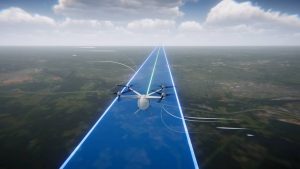Interview With J. Luke Bennecke, Author of Civil Terror: Gridlock
J. Luke Bennecke has an extensive background in civil engineering, with almost thirty years of experience related to transportation technology. Based in the Los Angeles area, he also has a lot of experience sitting in traffic. So when he decided to write a series of novels – beginning with Civil Terror: Gridlock – his frustration with the lack of well-managed transportation systems in our country despite the existence of ready-to-go technological solutions bubbled over. The result is a near-future thriller that imagines what could happen if a terrorist took over the computer systems linked to self-driving cars and traffic systems.
Recently I caught up with J. Luke Bennecke for this interview on what can be done to prevent the scenarios presented in Civil Terror: Gridlock.
Heidi: What sort of legal and ethical challenges do you think self-driving cars will pose?
J. Luke Bennecke: What types of legal and ethical challenges will self-driving cars impose?
Heidi: Right.
Bennecke: Well, that’s just it. We need to have a discussion. There’s not a lot of discussion going on as far as those legal and ethical issues. Right now, there are several—many different car companies coming out with proprietary, self-driving autonomous vehicle designs. They’re doing their testing on the public. The public roads.
Those are good questions. There was a lady killed two months ago by Uber in Arizona and who is at fault? Is it the chaperone driver? Is it the car owner? Uber? Is it the pedestrian? These are all questions that haven’t been thought about it yet and I think it’s important that we flush out these legal concepts first before we start testing on the public.
As far as ethics, there’s a lot of different benefits to implementing self-driving cars. If we can come up with a system to allow the vehicles to speak to one another and create a network, you’d have possibly a big chunk of the $160 billion a year that’s lost in economic productivity caused by traffic congestion. We should be able to recoup a lot of that. That’s a definite benefit.
Then there are 30-40,000 people killed by cars. 93% of them are typically caused by human error. Replacing the humans with robots or computers could save tens of thousands of lives every year. It’s a big, positive reason to implement this.
But at the same time, are we looking at the security measures? Most of the car companies, as far as I know, who are implementing their self-driving systems, aren’t really worried about hackers. It’s very easy right now to hack into a self-driving car. We want to do what we can to make these systems as secure as possible.
All of that there is wrapped up into the legal and potentially ethical issues that are posed for, as we move forward with the self-driving vehicle revolution.
Heidi: Okay. What are some things that engineers can do to better educate politicians and regulators about these issues and what can politicians do to make sure that experts get a seat at the table when discussing a legal framework for self-driving cars?
Bennecke: If you look at the current members of Congress, there are 535 members of Congress, in the House and Senate.
Heidi: Right.
Bennecke: About 40% of them are attorneys and there’s about 1% who are engineers. At the federal level, we have people in power who are mostly attorneys. Attorneys cause conflict. They cause problems. They don’t solve problems. Engineers solve problems.
So, the first thing we would need to do is empower the engineers to study the problem in detail and put forth solutions.
I don’t purport to have all of the answers, but I can assure you that if we put some of the best minds in our country, some of the best engineering minds in the country to task, then we have a great opportunity and a good chance of coming up with some viable solutions and then you would present those to the lawmakers and hopefully get a budget to implement some of the changes.
By good minds, I’m talking about not only the civil engineers, but mechanical engineers, electrical engineers, computer engineers. We would need the team to include psychologists, sociologists, social psychologists. We would want some attorneys in there to discuss the legal ramifications. Philosophy, some philosophers to discuss the different ethical ramifications. And you would round out your team with these experts.
Having that team of experts empowered by the federal government or different states, you have a very high probability of attacking the potential issues head on and coming up with some very good viable solutions.
Heidi: What should consumers and experts be doing to ensure that there will be common sense that apply equally to all self-driving cars without sacrificing innovation?
Bennecke: Well, that’s always the debate. I’m not particularly in favor of regulation, just for regulation’s sake. But in this case, having self-driving cars out on the public roads, some regulation needs to be implemented. The extent of the regulation, the top priority would be safety.
Again, I go back to the previous question and answer, putting that team of people together, the experts, you would want to discuss and come up with solutions to the extent of the regulations. I think the federal government would be the one responsible for implementing—coming up and implementing regulations, because cars drive from state to state. Trucks drive throughout dozens of states, sometimes on a single run. Having 50 different states with 50 different regulations doesn’t make any sense. It needs to come from the federal government so you have uniformity and consistency throughout the laws of the land and your truck drivers, the truck companies, and car companies and drivers can flow freely from state to state and not be in violation of the regulation in Nevada is different from the regulation in California, for example.
The details of those regulations would be determined by the team of people that I mentioned again previously, the experts. You want to have that balance. You don’t want to overregulate it to the extent that you’re stifling capitalist innovation. You want to embrace the capitalist innovation and promote it as much as possible.
I think we’d be surprised with some of the innovative techniques that private industry could come up with, so we want to have the federal government ideally partner with a number of different companies and work with them to come up with an optimal level solution for this issue that is good for business, it’s good for industry, it’s good for the population and it’s, like I said, is safe for everybody. It needs to be 100% bulletproof safe.
Heidi: Right. What are some of the current infrastructure challenges that need to be addressed to meet the promise that self-driving cars will reduce traffic accidents?
Bennecke: It’s very expensive to build additional lanes on the road. It’s about $2 million per lane mile to construct a new lane. Since the ‘50s, we’ve had freeways here in the United States and we built many, many thousands of lane miles all over the country and it’s getting to the point where the usefulness of a physical lane in a traditional sense with a human driver behind the wheel is no longer efficient. We have the technology right now to implement self-driving cars on a massive scale and that would be one of many different technologies that we can integrate into the existing infrastructure.
For example, right now, here in California, a decade or two ago, we started implementing ramp metering, which is a simple solution to preventing congestion on a freeway with a lane merge from people coming on the freeway. There are other technologies that are coming out in the next few years and in California, there’s several counties here in California that are on the cutting edge of implementing different smart technologies to improve the capacity of lanes.
I recently read of about some different technologies that keep track of cars and trucks on the freeway and help them with their spacing to improve the capacity of a lane by about 25%. If you had 4 lanes on a freeway and you can increase their capacity by 25%, that would be the same as adding another lane. That’s a great start.
Self-driving cars and their networks that will be coming out could increase the capacity of lanes by a factor of about 5, so 500%.
But again, going back to the safety, if the technology is not in place to prevent hackers from getting in and taking over your car, then all of that is for naught. We need to move forward into the future, hoping for the benefits that will be coming, but at the same time, we need to move forward with our eyes wide open and do everything possible to prevent some kind of a terrorist attack or from preventing hackers from taking over the cars.
One thing I would suggest would be to implement the changes incrementally in different phases so you would maybe put in a lane in the median—pick a lane that’s already on the left-most side toward the center of the freeway—and you convert that into a self-driving lane, similar to a toll lane. It’s a special lane, and you test. You get data and it’s an iterative process and you go back and forth and you try different solutions.
Some will work, some won’t, and you throw away the technology that doesn’t work and you enhance the technology that does work. And within a relatively short period of time, you should have something that can work on the larger scale.
Those are some techniques you could use to overcome the existing infrastructure challenges that we will face as we move forward with the self-driving revolution.
Heidi: Awesome. What can you tell me about the security challenges you address in your new book and how experts, corporations and regulators can do to address them?
Bennecke: That’s a great question. Any computer system out there right now is not 100% hacker-proof. We’ve had issues recently with the NSA and different large corporations who’ve been hacked by computer experts looking to steal private data.
We need to fix that. We need to plug those holes and however we need to do that, encryption software is good, but it needs to be better. Whatever computer cyber security systems need to be put in place, they need to be 100% bulletproof. It won’t be enough to have something that’s 99.99% secure. It needs to be 100%. It has to be secure. It has to be no way for a hacker to get into your car.
As far as I know, like I mentioned earlier, I don’t believe the car manufacturers that are coming out with the inventions for self-driving cars, they’re not putting a lot of stock or effort into making their systems secure. I think that’s a problem. We need to address that immediately.
And like I said towards the beginning, we need to get the best and brightest minds together and talk about this. One of the issues they need to talk about will be security of each individual car and the network, if that’s the path that we end up going down. You need to have again, 100% secure systems.
I’m not a cyber crimes expert. People who are, and this is a very complicated field, it’s evolving, and we need to get some of those cyber crime experts onto the team so that from security standpoint it’s 100% bulletproof.









